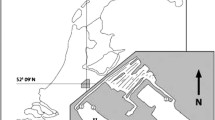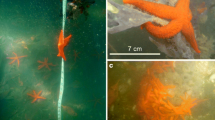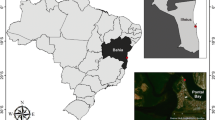Abstract
The aim of this research was to determine if population attributes and growth of an estuarine pulmonate could be used as bioindicators of environmental conditions in New Zealand estuaries. We quantified the size distribution of the deposit feeding Amphibola crenata in areas which contrasted in contaminant inputs. Within a small estuary, location and tidal level significantly affected A. crenata density. The highest mean abundances were found at the most contaminated site, close to the waste treatment discharge point, compared with lower densities at two river sites and close to the estuary mouth. The population structure was site-specific with juveniles present in historically contaminated areas. Growth of A. crenata held in experimental cages for 6 weeks was highest for medium length individuals from close to the waste discharge point and least for individuals from the estuary mouth. Sediment surface microalgal biomass (chlorophyll a), representing the potential food supply for A. crenata was greatest at the least contaminated site, and lowest at the most polluted site. The abundance, population structure and growth rate of A. crenata are attributes that may be used as ecological bioindicators, reflecting the complex environmental conditions within New Zealand estuaries.







Similar content being viewed by others
References
Adams, S. M. & M. S. Greeley, 2000. Ecotoxicological indicators of water quality:using multi-response indicators to assess the health of aquatic ecosystems. Water, Air and Soil Pollution 123: 103–115.
Alfaro, A., 2010. Effects of mangrove removal on benthic communities and sediment characteristics at Mangawhai Harbour, northern New Zealand. ICES Journal of Marine Science 67: 1087–1104.
Armitage, A. R., V. L. Gonzalez & P. Fong, 2009. Decoupling of nutrient and grazer impacts on a benthic estuarine diatom assemblage. Estuarine, Coastal and Shelf Science 84: 375–382.
Bennington, S. L., 1979. Some Aspects of the Biology and Distribution of Amphibola crenata (Gastropoda: Pulmonata) with Special Reference to Possible Effects of Pollution from Sewage Outfalls, Thesis (D. Phil), University of Canterbury, New Zealand.
Bolton-Ritchie, L., 2008. Healthy Estuary and Rivers of the City: Water Quality and Ecosystem Health Monitoring Programme of Ihutai. The Sediments and Biota of the Avon-Heathcote Rivers. Summary Report on Data Collected in 2007. Environment Canterbury Report.
Bolton-Ritchie, L. & M. Main, 2005. Nutrient Water Quality Avon-Heathcote Estuary/Ihutai: Inputs, Concentrations and Potential Effects, Report No. U05/71, Environment Canterbury.
Borja, A., I. Muxila & J. Franco, 2000. The application of a marine biotic index to different impact sources affecting soft-bottom benthic communities along European coasts. Marine Pollution Bulletin 46: 835–845.
Botherway, K. J. & J. P. A. Gardner, 2002. Effect of storm drain discharge on the soft shore ecology of Porirua Inlet, New Zealand. New Zealand Journal of Marine and Freshwater Research 36: 241–255.
Briggs, I., 1972. The Feeding Ecology and Energetic of a Population of Amphibola crenata. MSc Thesis, University of Canterbury.
Cabral, H. N. & A. G. Murta, 2004. Effect of sampling design on abundance estimates of benthic invertebrates in environmental monitoring studies. Marine Ecology Progress Series 276: 19–24.
Cantillo, A. Y., 1998. Comparison of results of mussel watch programs of the United States and France with worldwide mussel watch studies. Marine Pollution Bulletin 36: 712–771.
Cardoso, P. G., A. I. Lillebo, M. A. Pardal, S. M. Ferreira & J. C. Marques, 2002. The effect of different primary producers on Hydrobia ulva population dynamics: a case study in a temperate intertidal estuary. Journal of Experimental Marine Biology and Ecology 277: 173–195.
Cardoso, P. G., M. A. Pardal, D. Raffaelli, A. Baeta & J. C. Marques, 2004. Macroinvertebrate response to different species of macroalgal mats and the role of disturbance history. Journal of Experimental Marine Biology and Ecology 308: 207–220.
Cardoso, P. G., M. Bankovic, D. Raffaelli & M. A. Pardal, 2007. Polychaete assemblages as indicators of habitat recovery in a temperate estuary under eutrophication. Estuarine, Coastal and Shelf Science 71: 301–308.
Christchurch Drainage Board, 1988. Heavy Metals in the Rivers and Estuaries of Metropolitan Christchurch and Outlying Areas. March 1988, 221 pp.
Dudley, B. D. & J. S. Shima, 2010. Algal and invertebrate bioindicators detect sewage effluent along the coast of Titahi Bay, Wellington, New Zealand. New Zealand Journal of Marine and Freshwater Research 44: 39–51.
Franz, D. R. & I. Friedman, 2002. Effects of a macroalgal mat (Ulva lactuca) on estuarine sand flat copepods: an experimental study. Journal of Experimental Marine Biology and Ecology 271: 209–226.
Grudemo, J. & T. Bohlin, 2000. Effects of sediment type and intra- and interspecific competition on growth rate of the marine snails Hydrobia ulvae and Hydrobia ventrosa. Journal of Experimental Marine Biology and Ecology 253: 115–127.
Hagerthey, S. E., E. C. Defew & D. M. Paterson, 2002. Influence of Corophium volutator and Hydrobia ulvae on intertidal benthic diatom assemblages under different nutrient and temperature regimes. Marine Ecology Progress Series 254: 47–59.
Hierarchical Monitoring Methods (HIMOM) [CD-ROM], 2002. A Research Project Supported by the European Commission under the Fifth Framework Programme and Contributing to the Implementation of the Key Action Sustainable Marine Research within the Energy, Environment and Sustainable Development Programme.
Jeffrey, S. W. & G. F. Humphrey, 1975. New spectrophotometric equations for determining chlorophyll a, b, c1 and c2 in higher plants, algae and natural phytoplankton. Biochemie und Physiologie der Pflanzen 167: 191–194.
Jones, M. B. & I. D. Marsden, 2005. Life in the Estuary. Illustrated Guide and Ecology. University of Canterbury Press, Christchurch.
Juniper, S. K., 1981. Stimulation of bacterial activity by a deposit feeder in two New Zealand intertidal inlets. Bulletin of Marine Science 31: 691–701.
Juniper, S. K., 1982. Regulation of Microbial Production in Intertidal Mudflats – The Role of Amphibola crenata, a Deposit Feeding Gastropod, PhD Thesis, University of Canterbury.
Juniper, S. K., 1987a. Deposit feeding ecology of Amphibola crenata I. Long-term effects of deposit feeding on sediment micro-organisms. New Zealand Journal of Marine and Freshwater Research 21: 235–246.
Juniper, K., 1987b. Deposit feeding ecology of Amphibola crenata II. Contribution of microbial carbon to Amphibola’s carbon requirements. New Zealand Journal of Marine and Freshwater Research 21: 247–251.
Kim, S.-J., M. Rodriguez-Lanetty, J.-H. Suh & J.-J. Song, 2003. Emergent effects of heavy metal pollution at a population level: Littorina brevicula a study case. Marine Pollution Bulletin 46: 74–80.
Knox, G. A., 1992, The Ecology of the Avon-Heathcote Estuary. A Report Prepared for the Christchurch City Council and the Canterbury Regional Council
Little, C., C. Pilkington & J. B. Pilkington, 1984. Deveolopment of salinity tolerance in the marine pulmonate Amphibola crenata (Gmelin). Journal of Experimental Marine Biology and Ecology 74: 169–177.
Luoma, S. N. & P. S. Rainbow, 2008. Metal Contamination in Aquatic Environments. Cambridge University Press, Cambridge: 588 pp.
Macpherson, J. M., 1978. Environmental Geology of the Avon-Heathcote Estuary, PhD Thesis, Department of Geology, University of Canterbury.
Maher, W. A. & R. H. Norris, 1990. Water quality assessment programmes in Australia: deciding what to measure, and how and where to use bioindicators. Environmental Monitoring and Assessment 14: 115–130.
Marsden, I. D., 2002. Life-history traits of a tube-dwelling corophioid amphipod, Paracorophium excavatum exposed to sediment copper. Journal of Experimental Marine Biology and Ecology 270: 57–72.
Marsden, I. D., 2004. Laboratory and field experiments investigating the effects of reduced salinity and seston availability on growth of the little-neck clam Austrovenus stutchburyi. Marine Ecology Progress Series 266: 157–171.
Marsden, I. D. & G. A. Knox, 2008. Chapter 23. Estuaries, Harbours and Inlets. In Winterbourn, M., G. A. Knox, C. Burrows & I. D. Marsden (eds), Natural History of Canterbury. University of Canterbury Press, New Zealand: 735–770.
Marsden, I. D. & S. R. Maclaren, 2010. Short-term study testing the resilience of an estuarine bivalve to macroalgal mats. Hydrobiologia 649: 217–229.
Marsden, I. D. & P. S. Rainbow, 2004. Does the accumulation of trace metals in crustaceans affect their ecology – the amphipod example. Journal of Experimental Marine Biology and Ecology 30: 373–408.
Marsden, I. D., C. H. Wong & N. Al-Mudaffir, 2000. Assessment of an estuarine amphipod (Paracorophium excavatum) as a bioindicator of contaminated sediment. Australian Journal of Ecotoxicology 6: 21–30.
Marsden, I. D., P. S. Rainbow & B. D. Smith, 2003. Trace metal concentrations in two New Zealand talitrid amphipods: effects of gender and reproductive state, and implications for biomonitoring. Journal of Experimental Marine Biology and Ecology 290: 93–113.
McMurtrie, S., 2007. Benthic survey of the Avon-Heathcote Estuary/Ihutai: 2007. EOS Ecology Report 06059-CCC05-0.
Miller, L. P. & B. Gaylord, 2007. Barriers to flow: the effects of experimental cage structures on water velocities in high-energy subtidal and intertidal environments. Journal of Experimental Marine Biology and Ecology 344: 215–228.
Mistri, M., R. Rossi & E. A. Fano, 2001. Structure and secondary production of a soft bottom macrobenthic community in a brackish lagoon (Sacca di Goro, north-eastern Italy). Estuarine Coastal and Shelf Science 52: 605–616.
Morris, L. & M. J. Keough, 2003. Variation in the response of intertidal infaunal invertebrates to nutrient additions: field manipulations at two sites within Port Phillip Bay, Australia. Marine Ecology Progress Series 250: 35–49.
Morton, B. & K. Chan, 2004. The population dynamics of Nassarius festivus (Gastropoda: Nassariidae) on three environmentally different beaches in Hong Kong. Journal of Mollusc Studies 70: 329–339.
Norkko, J., S. F. Thrush & R. M. G. Wells, 2006. Indicators of short-term growth in bivalves. Detecting environmental change across ecological scales. Journal of Experimental Marine Biology and Ecology 337: 38–48.
Norkko, J., A. Norkko, S. F. Thrush, S. Valanko & H. Suurkuukka, 2010. Conditional responses to increasing scales of disturbance, and potential implications for threshold dynamics in soft-sediment communities. Marine Ecology Progress Series 413: 253–266.
Oliveira, C., J. Amelda, L. Guilhermino, M. V. M. Soares & C. Gravato, 2012. Acute effects of deltamethrin on swimming velocity and biomarkers of the common prawn Palaemon serratus. Aquatic Toxicology 124–125: 209–216.
Peake, B. M., I. D. Marsden & A. M. Bryan, 2006. Spatial and temporal variations in trace metal concentrations in the cockle, Austrovenus stutchburyi from Otago, New Zealand. Environmental Monitoring and Assessment 115: 119–144.
Pearson, T. H. & R. Rosenberg, 1978. Macrobenthic succession in relation to organic enrichment and pollution of the marine environment. Oceanographic Marine Biology Annual Review 16: 229–311.
Pechenik, J. A., I. D. Marsden & O. Pechenik, 2003. Effects of temperature, salinity, and air exposure on development of the estuarine pulmonate gastropod Amphibola crenata. Journal of Experimental Marine Biology and Ecology 292: 159–176.
Perez, K. O., R. L. Carlson, M. J. Shulman & J. C. Ellis, 2009. Why are intertidal snails rare in the subtidal? Predation, growth and the vertical distribution of Littorina littorea (L.) in the Gulf of Maine. Journal of Experimental Marine Biology and Ecology 369: 79–86.
Pilkington, M. C. & J. B. Pilkington, 1984. Settlement of the New Zealand mud snail, Amphibola crenata. Journal of the Royal Society of New Zealand 14: 145–149.
Plante, C., S. Feipel & J. L. Wilkie, 2010. Disturbance effects of deposit feeding on microalgal community structure and mechanisms of recolonisation. Journal of Phycology 46: 907–916.
Rainbow, P. S., 2002. Trace metal concentrations in aquatic invertebrates: why and so what? Environmental Pollution 120: 497–507.
Rainbow, P. S., B. D. Smith & S. S. S. Lau, 2002. Biomonitoring of trace metal availabilities in the Thames estuary using a suite of littoral biomonitors. Journal of the Marine Biological Association UK 82: 793–799.
Rodrigo, A. G., 1985, The Avon-Heathcote Estuary: An Analysis of the Distribution of Sediments and their Associated Heavy Metals with Special Reference to its Effects on the Distribution of the Mudflat Snail, Amphibola crenata. B.Sc Project Report, University of Canterbury.
Scott, G. R. & K. A. Sloman, 2004. The effects of environmental pollutants on complex fish behaviour: integrating behavioural and physiological indicators of toxicity. Aquatic Toxicology 68: 369–392.
Shriver, A. C., R. H. Carmichael & I. Valiela, 2002. Growth, condition, reproductive potential, and mortilaity of bay scallops, Argopecten irradians, in response to eutrophic-driven changes in food resources. Journal of Experimental Marine Biology and Ecology 279: 21–40.
Shumway, S. E., 1981. Factors affecting oxygen consumption in the marine pulmonate Amphibola crenata (Gmelin, 1791). Biological Bulletin 160: 332–347.
Shumway, S. E. & I. D. Marsden, 1981. The combined effects of temperature, salinity and declining oxygen tension on oxygen consumption in the marine pulmonate Amphibola crenata (Gmelin). Journal of Experimental Marine Biology and Ecology 6: 1133–1146.
Stevenson, M., 2010. Healthy Estuary and Rivers of the City. Water Quality and Ecosystem Health Monitoring Programme of Ihutai. Report No. R10/140. Environment Canterbury
URS NZ Ltd., 2001. Assessment of Environmental Effects for Christchurch Wastewater Discharge, Prepared for Christchurch City Council.
Usero, J., J. Morillo & I. Gracia, 2005. Heavy metal concentrations in molluscs from the Atlantic coast of southern Spain. Chemosphere 58: 118–1175.
Voller, R. W., 1973. Salinity, Sediment, Exposure and Invertebrate Macrofaunal Distributions on the Mudflats of the Avon-Heathcote Estuary, Christchurch, New Zealand, Thesis (M.Sc), Department of Zoology, University of Canterbury.
Walrond, D., 2008. The Effect of Contamination on the Benthic Population of the Avon-Heathcote Estuary, Christchurch, New Zealand, Thesis (BSc), University of Birmingham.
Watters, P. A., 1964. Distribution of A. crenata in Dunedin. Transactions of the Royal Society of New Zealand Zoology 4: 117–134.
Wilson, J. G., 1988. The Biology of Estuarine Management. Croom Helm, London.
Acknowledgments
We would like to thank Jan McKenzie, School of Biological Sciences for helping with the fieldwork, and John Zeldis from NIWA, Christchurch for facilitating measurement of benthic chlorophyll levels. The research was undertaken as part of a Professional Placement Abroad Programme from the School of Geography, Earth and Environmental Sciences, University of Birmingham, UK. We would also like to thank two anonymous referees for their valuable feedback on the manuscript.
Author information
Authors and Affiliations
Corresponding author
Additional information
Handling editor: K.W. Krauss
Rights and permissions
About this article
Cite this article
Marsden, I.D., Swinscoe, I. Does population structure and growth of an intertidal pulmonate snail reflect environmental conditions within a small estuary?. Hydrobiologia 724, 141–155 (2014). https://doi.org/10.1007/s10750-013-1730-3
Received:
Revised:
Accepted:
Published:
Issue Date:
DOI: https://doi.org/10.1007/s10750-013-1730-3




